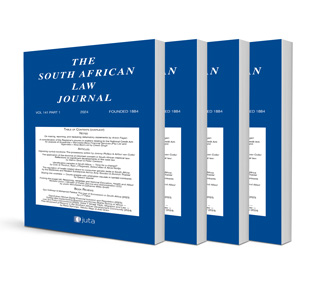Regspraak: Huweliksgoedereregtelike bedeling lukraak terugwerkend gewysig én die betrokkenes se handelingsbevoegdheid só verminder?

Regspraak: Huweliksgoedereregtelike bedeling lukraak terugwerkend gewysig én die betrokkenes se handelingsbevoegdheid só verminder?
Author: JC Sonnekus
ISSN: 1996-2207
Affiliations: Universiteit van Johannesburg
Source: Tydskrif vir die Suid-Afrikaanse Reg, Issue 1, 2023, p. 140-156
https://doi.org/10.47348/TSAR/2023/i1a9
Abstract
Legal certainty will be severely jeopardised should it be possible at whim to proclaim the applicable matrimonial property regime governing spouses’ assets and liabilities to have been changed retroactively. The legislature prescribed clearly defined prerequisites to be met before any change regarding a couple’s matrimonial property regime can be sanctioned by the high court and then only for the future, but never with retrospective force. Under the dualistic systems that apply in South Africa since 1652 it has always been recognised that individuals living according to customary or indigenous law may by default govern their matrimonial property regimes and the law of husband and wife according to the applicable norms of indigenous law. By default these marriages were out of community of property although a couple could agree to change the default position and have their consensus in this regard registered. The couple M was married according to customary law in the erstwhile Eastern Cape in 1980 and the marriage was never registered. The default position should accordingly govern the matrimonial property regime of the couple resulting in no community of property and no accrual system. The husband’s legal capacity and competencies were consequently not restricted by the qualifications contained in section 15 of the Matrimonial Property Act 88 of 1984 because that chapter of the act was not applicable to a customary marriage concluded in 1980 and which is by default out of community of property. When the husband as registered sole owner in 2010 entered into a valid sale agreement to transfer his immovable property on the Cape Flats to the first respondent nothing hampered or restricted the parties’ capacity to enter into the applicable obligatory or real agreements. The property was subsequently validly transferred in the Deeds Register to the purchaser. The plaintiff’s claim as widow of the seller who since passed away, to have the property “retransferred” into her name because the sale and transfer was allegedly in contravention of section 15 of Act 88 of 1984, is unconvincing although the court held otherwise. The crux of the matter is not whether the first respondent should be safeguarded against the consequences of an alleged invalid agreement by the husband who acted without the involvement of his wife in 2010 by a reliance on section 15(9)(a) of that act. The emphasis should have been on how the alleged amendment of section 7(2) of Act 120 of 1998 in June 2021 could be deemed to apply retrospectively after the sale and transfer had validly been concluded for eleven years before the poorly formulated amendment of the act became law in June 2021. A contract of sale that was validly concluded cannot retrospectively become invalid because the legislature changed the requirements for the type of contract more than a decade later. The court’s point of departure for its judgment is, however, that the deceased was married in community of property: “The Recognition of Customary Marriages Amendment Act 1 of 2021, which came into operation on 1 June 2021, among others, amended section 7 of the RCMA that all marriages, which were entered into before or after the enactment of the RCMA, are regarded as in community of property unless such consequences are specifically excluded by the spouses in an antenuptial contract” (par 20). This, notwithstanding the clear legal position regarding the default matrimonial property regime for all indigenous marriages concluded before the commencement of Act 120 of 1998: out of community of property. The legislature was supposed to adhere to the decision of the constitutional court in 2017 in Ramuhovhi v President of the Republic of South Africa (2018 2 SA 1 (CC)) to amend section 7(1) of Act 120 of 1998 with regard to polygamous marriages and not to alter the legal position regarding monogamous marriages that were governed without any found negative consequences by section 7(2) of that act. Although the legislature neglected to explicitly declare that this amendment of section 7(2) should have no impact retrospectively, the implications of this poorly conceived judgment will necessitate a re-opening of all the millions of estates of people who have been married according to a customary marriage since 1652 because all those marriages will now be deemed to have been in community of property with the consequential implications for the distribution of all assets of the spouses involved with the dissolution of the marriages after the demise of the dying spouse. The legislature would have caused less harm if it read with comprehension the clear order of the constitutional court: “In terms of s 172(1)(b) of the Constitution, this order does not invalidate a winding up of a deceased estate that has been finalised or the transfer of marital property that has been effected.”
